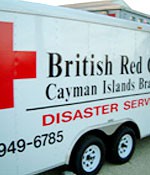

It is up to you to decide on the best place for your family and yourself during a storm. Public shelters are provided in each district but space is limited and is meant for people whose homes cannot be made safe and who can’t find another safe place to stay. If your home is hurricane-proof and is in a safe location it is probably the best place to be during a storm. The next best place is with family or friends whose house is well-constructed and in a safe location. However, if you have no other alternative or are not sure, do not hesitate to go to a public shelter. Here are some tips to help you decide.
If you can, get a structural engineer to do a proper assessment.
If you can not, plan to stay with someone in a safer location or to go to a shelter.
Storms can bring several inches of rainfall and if this rain has nowhere to run off it will cause flooding. A storm surge can then add several more feet of water, from four ft. or less in a category one storm, to 18 ft. or higher in a strong category five. Find out how high above sea level your property is. Measure how high above the ground outside the threshold of your door is. Add these two measurements together to see how high above normal sea level the floor of your dwelling is. Suppose your area is two ft. above normal sea level and the floor of your house is two ft. above that. It means you are four ft. above normal sea level. If there is a storm surge of six ft., you could get two ft. of water inside your house.
A number of governement buildings in each district are chosen and equipped to serve as public shelters. The HMCI chooses these based on the buildings' ability to withstand hurricane conditions and there height above sea level. As newer, purpose-built centres are constructed the HMCI phases out older shelters that are not as ideal.
Supplies at the shelter are for post hurricane use, so each person must bring:
The management team is in charge of the shelter. They are trained for this function. Items not allowed in the shelter will be confiscated and the owners asked to sign for them. The items will be returned to the owners when they are leaving the shelter.
REMEMBER
Many people have to share a small space in a shelter. Be prepared for some amount of discomfort. Safety is the main concern, so follow shelter wardens' instructions
If you’re satisfied your house and location are safe and you decide to stay:
If you consider you will be at risk, decide on a plan for you and your family in advance:
In cases where the Hazard Management Cayman Islands feels an area is at special risk it will issue an Evacuation Order for that area. This means that all residents in that area should leave at once and go to a designated shelter or other safe location outside the evacuation area. Listen out for these orders as they could come at any time before or during the storm. Announcements will be given by radio and TV and by police and firemen, who will come around the community with loud speakers.
If you refuse to leave when authorities recommend evacuation you will have to sign a release form. This means the authorities cannot be held responsible for you. If you are ordered to evacuate, do so immediately!
Never ignore an evacuation order. All storms are unpredictable and can be life-threatening. Wind, debris and rising water could leave you suddenly trapped at a time when no help can reach you.
Take only essential items with you. Leave pets indoors in a safe, covered area with ample food and water. If you have time, turn off the gas, electricity, and water if you have not already done so; unplug all appliances.
Have each family member take their Survival Kit. When you leave home, If you are driving, follow any instructions by authorities regarding passable routes—others may be blocked. Expect heavy traffic.